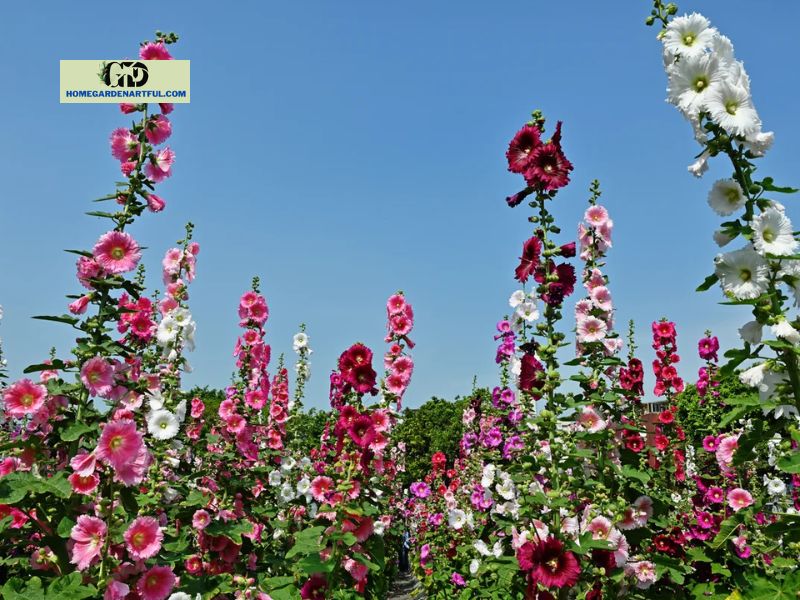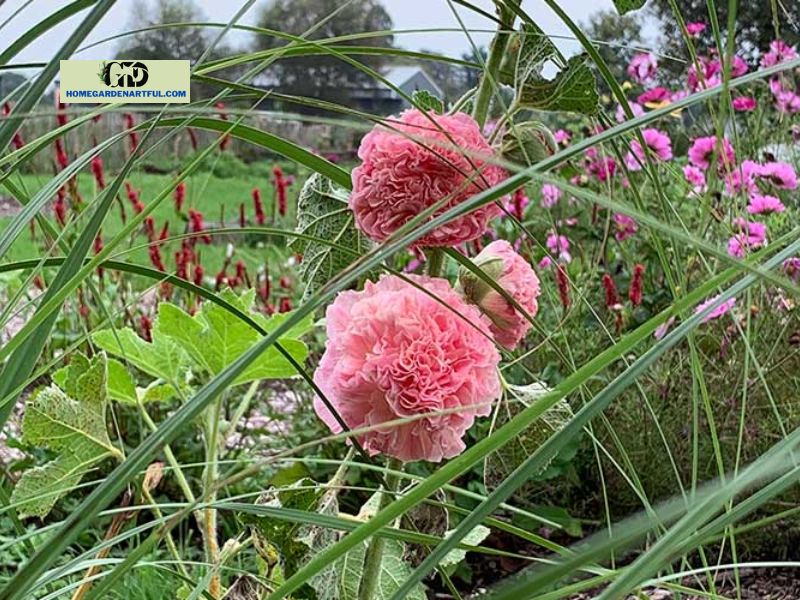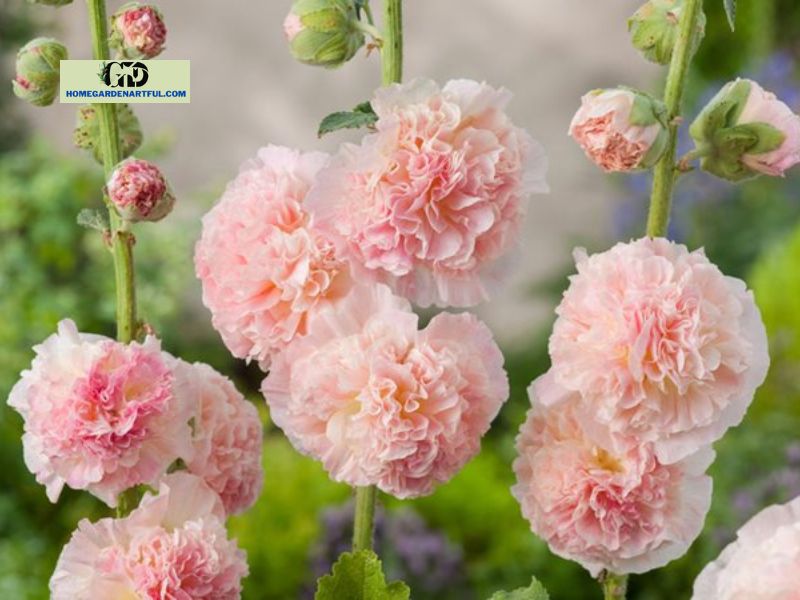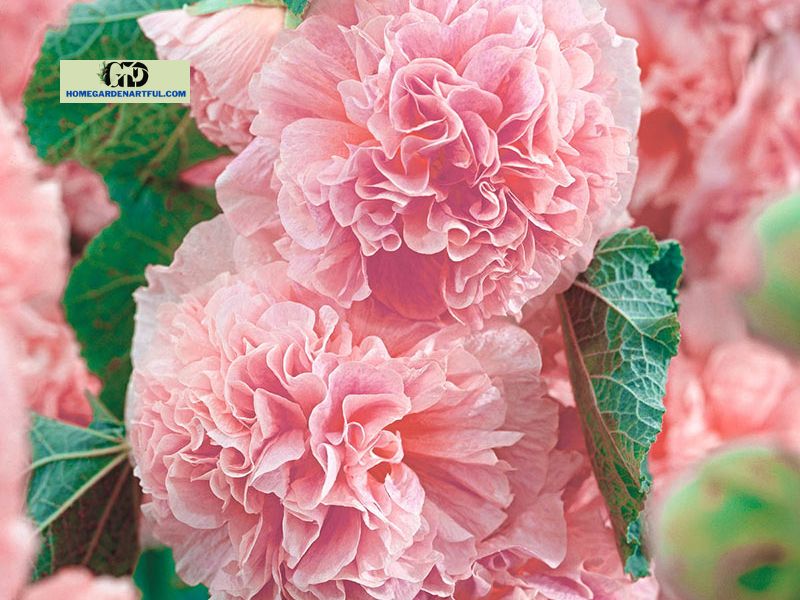How beautiful Double Petal Hollyhock are! A never-ending supply of blooms! Home flower gardeners prefer growing hollyhocks in borders or against walls and fences, where their magnificent blossoms tower over everything else.
For over a century, the classic variety has graced village gardens, outbuildings, and farmsteads. They are particularly enticing to butterflies and hummingbirds! Discover at homegardenartful.com!
Double Petal Hollyhock Care

Double Petal Hollyhock is a traditional garden plant that blooms in midsummer with multiple flowers on tall spikes.
Many of the most popular types are biennials, meaning they live for two years and come in a wide range of colors.
The first year is spent growing foliage, while the second year is spent growing stems, blooms, and seeds.
However, many kinds behave like short-lived perennials as well as will flower in their first year if planted early in the spring or started indoors in the winter.
Hollyhocks take little care other than staking and trimming back the stalks after flowering, but they must be kept from insects and fungal diseases like rust.
They attract pollinators such as bees, hummingbirds, and butterflies as well as serve as a host plant for painted lady butterfly caterpillars.
Light
Most double-petal hollyhocks may tolerate partial shade but prefer full sun. These tall plants may flop in areas with too much shade.
If you live in a hot, dry climate, the bottom leaves of your hollyhock will not dry out if you place it in partial shade.
Hollyhocks may grow in a variety of soil conditions. While rich, well-drained soil is preferable, adding organic matter to your plants’ soil will sometimes stimulate their growth in less-than-perfect growing conditions.
This will increase air circulation and drainage as well.
Water
When starting hollyhocks, water them periodically and keep the soil moist. They are, however, drought-hardy once grown.
When watering, avoid soaking the foliage; this can lead to damaged leaves.
Humidity and temperature

These plants thrive best in temperate climates.
Although some species can tolerate temperatures as low as 0 degrees Fahrenheit, they are not exceptionally cold-hardy, and frosts in the early fall can affect late blooms.
These plants dislike high humidity because of their sensitivity to rust.
Hollyhocks need fertile conditions and flourish in soils with high nutrient levels. You may notice browning foliage and fewer blossoms if you don’t have it.
If your soil isn’t rich, a light spring application of fertilizer and compost can help.
Pruning
Individual hollyhock flowers can be plucked as they fade, and entire stalks can be trimmed back to the ground once the flowering period is over. This will prevent seed heads from forming and reseeding.
If you want seeds for the next spring, leave the blooms and a few stalks on the plant till the seeds have fallen.
To avoid the spread of rust disease, all the leaves and stems should be trimmed back to the ground in the winter.
Overwintering
Depending on where you reside, your Hollyhocks may require particular winter care. In any area, it is ideal to prune leaves and stems before the fall.
In frost-prone areas, put organic material over the root zone to protect the roots of your Hollyhocks.
In hard frost zones, hollyhocks can be produced as annuals by planting seeds in containers as well as overwintering them indoors.
During the winter, water them sparingly and gradually return them to the outside when the weather warms.
In regions where they can be kept outside, prune them to approximately 6 inches above ground in the fall. Cover the plant’s roots and base with 4 to 6 inches of straw or mulch.
Remove the mulch gradually, layer by layer, in the spring to give the roots time to acclimate. Remove all of the straw or mulch once you notice fresh growth.
Cover again in the spring in case it freezes.
Double Petal Hollyhock Planting and Growing Instructions

Hollyhocks prefer full sun to partial shade, as well as rich, moist soil.
Work plenty of organic materials into the garden before planting, such as compost or aged animal dung. This contributes to soil conditioning, which increases drainage and increases the soil’s ability to hold water and nutrients.
Planting Hollyhock Seeds
Sow hollyhock seeds outdoors 1-2 weeks before the final frost, just beneath the surface of the soil. The seeds germinate in 10-14 days. After seedlings have sprouted, thin them to 18-36 inches apart.
Due to the lengthy taproots of hollyhocks, it is preferable to start indoor hollyhock seeds in tall, individual pots as well as transplant them as soon as possible to avoid damage.
During dry spells, water as needed to keep flowers blossoming. Using an organic flower fertilizer on a regular basis will produce larger, more vibrant blooms. When the flowers have faded, clip the stalks to the ground.
Common Pests and Plant Disease
Thrips, Japanese beetles, sawflies, and spider mites are among the horticultural pests that attack Double Petal Hollyhocks. Keep an eye on everything and fix any problems right away with organic insecticides.
They are susceptible to hollyhock rust, a fungal ailment that begins as yellow spots on the leaves and progresses to brown or rust-colored pimples on the underside of the leaves.
Keeping rust at bay is far less difficult than dealing with a full-fledged epidemic. Stopping rust will be much easier if you water from below, maintain excellent air circulation, and clean up thoroughly at the end of the season.


